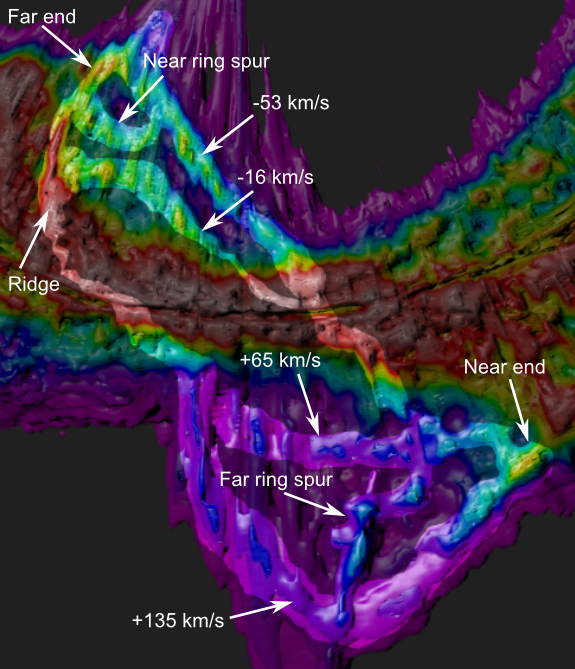Velocity surprise

Rotation models for the Milky Way compress the predicted observed velocity to zero in the centre (0°) and anticentre (180°) directions and indeed the spiral arm velocities in the LAB survey are all severely compressed (although not quite to zero) in these directions. It was therefore very surprising to Dutch radio astronomers in the 1950s when they detected a prominent structure towards the centre of the Milky Way that had a very negative velocity of -53 km/s. This velocity could not be associated with rotation and the structure did not appear to be a spiral arm. What could it be?
The astronomers decided that the best explanation was that this was a large region of gas expanding away from the galactic centre. They called the structure the "3kpc arm" because it appeared to be located about 3000 parsecs from the galactic centre. [van Woerden et.al. 1957, Rougoor, G. W.; Oort, J. H. 1959] In 2008, another "arm" was reported on the far side of the bar with a velocity of +56 km/s. [Dame, T. M.; Thaddeus, P. 2008].
As these structures are not spiral arms and appear to ring the galactic bar, I am using the term "ring" rather than "arm" for them on this site.
Note that the recent discovery that the ring is elliptical rather than circular in shape means that the observed anomalous velocities can be explained more simply by a rotating elliptical structure rather than gas expanding away from the galactic centre. [Source needed]
Double ring
You can view the LAB ring velocity data in the Velocity Explorer. I have also provided a labelled diagram of the same velocity data on this page. I've followed the convention of naming the observed structures after the anomalous velocities observed for them in the galactic centre direction (0°). I've kept the traditional "-53 km/s" and "+135 km/s" names even though the centre of the LAB velocity data for these structures appears to be closer to -50 km/s and +123 km/s in the 0° direction.
As you can see in the velocity data, the ring is not a simple elliptical structure. It is in fact a double ring that also has two associated spurs.
The -53 km/s structure (the "3kpc arm") is clearly visible. However, so is a somewhat fainter structure at -16 km/s (which is a partial edge that does not touch the ring ends). On the far side of the galaxy, we also observe two edges of the double ring at +65 km/s and +135 km/s. The velocity width of the structures on the far side of the galaxy is very large. The +56 km/s structure reported by Dame and Thaddeus in 2008 appears to be part of the structure visible in the LAB data which is centred at +65 km/s.
The +135 km/s structure is more prominent than the +65 km/s structure and has been known for decades. It has been discussed in several papers, for example, Sanders, R. H.; Wrixon, G. T. 1972.
The structure identified in the image as the "far ring spur" appears to be the same as the structure identified in the literature as the "connecting arm" and may actually lie within the bar. [Fux 1999].
Mapping the ring
Given that the ring velocities are not primarily from rotation, it is impossible to derive a detailed map from them. It is possible, for example, that the +65 km/s edge is interior to the +135 km/s edge, exterior to it, or even coincident with it, with hydrogen clouds from two different velocity ranges found together in the same region. We will need many more parallax measurements of the ring before we can determine its structure.
The LAB velocity survey does provide two crucial pieces of data useful for mapping however: the far end of the ring begins at about 337° and the near end ends at about 22°. The rest of the ring is found in between. Two parallax measurements are currently available for star formation regions that may be associated with the ring. These are G9.62+0.20 (5200 pc) and G23.4-0.2 (5880(-930/+1360) pc).
Using the ring boundary data, assuming for now that these two objects are in the ring and assuming for now that the ring is an ellipse, then we can derive a rough model for the ring, as shown in the image towards the bottom of this section. This orientation is roughly similar to the orientation shown in Robert Hurt's schematic of the Milky Way, which is largely derived from infrared data. The velocity data described in this section suggests that the ring is more complex in structure than a simple ellipse, however.
The bar
The bar, a roughly elliptical region interior to the ring, contains dense star clusters, intense radio sources and the 4 million solar mass black hole Sgr A*. It does not, however, contain much atomic hydrogen. We see a similar lack of atomic hydrogen in other galactic centre regions. For example, see the atomic hydrogen map of Messier 101 in the Mapping hydrogen section. Perhaps the atomic hydrogen is largely consumed by the intense star formation that takes place in galactic centres.
One interesting implication of the ring model described on this site is that the centre of the ring and bar is not the rotational centre of the galaxy (Sgr A*) but is instead located about 350 parsecs nearer the Sun. Given the likely unsymmetrical distribution of matter in the ring and bar, perhaps it is not surprising that they do not centre exactly on Sgr A*. (Note that our model adopts the distance estimate of 8400 pc. If we used a smaller distance estimate for the galactic centre, the ring and bar centre would be closer to the rotational centre.) A 2007 paper concludes (see their Figure 5) that the bar extends more into the fourth quadrant than the first quadrant [López-Corredoira, M et.al. 2007], and this is also true for the model used on this site.
